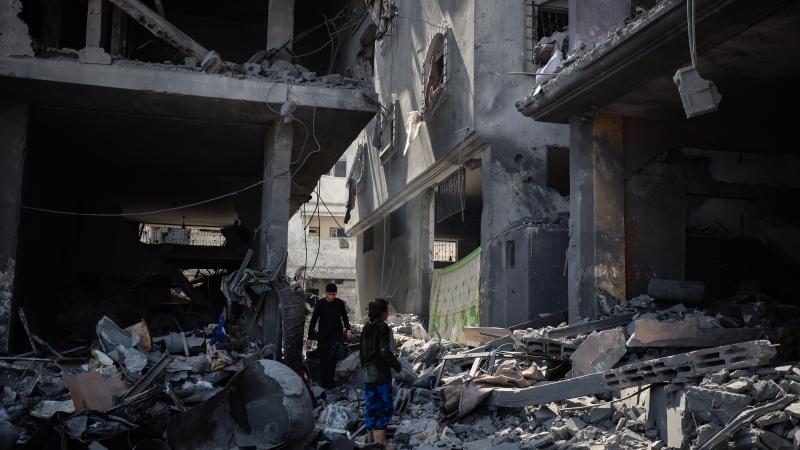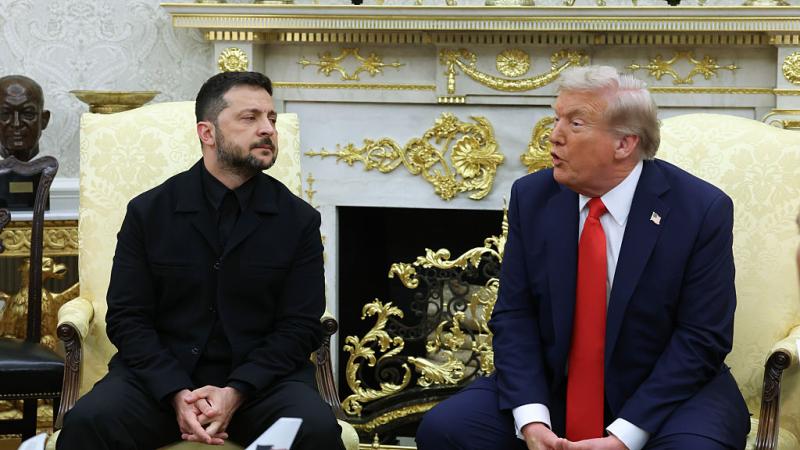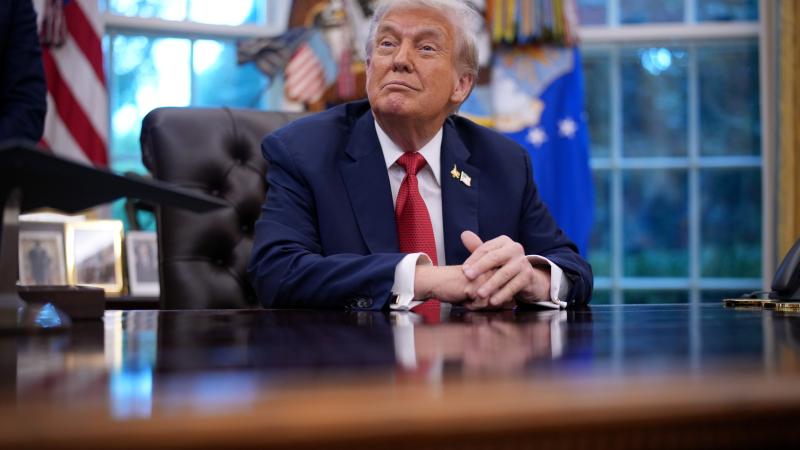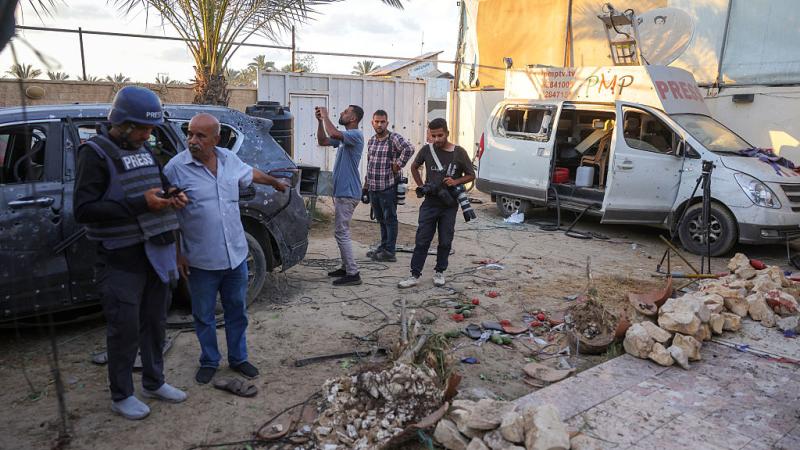Hegseth presses defense industry to ramp up munitions amid depleted stocks, China threat
The U.S. military is facing shortages of critical and much-needed munitions. Secretary of Defense Hegseth made a personal appeal to defense industry leaders to help fix the problem.
Secretary of Defense Pete Hegseth gathered some of the leaders of America’s largest military contractors for a closed-door meeting at the Pentagon last week, urging them to ramp up the production of critically needed munitions amidst depleted weapons stocks and a growing threat from China, Just the News has learned.
A senior Trump administration official, who declined to be named in order to describe a private discussion, told Just the News that the main reason for Thursday’s closed-door meeting with defense company leaders — which included well-known firms such as Raytheon, Lockheed Martin, and BAE Systems — was to seek to hold munitions manufacturers accountable so that U.S. warfighters are equipped to face 21st century threats.
The closed-door meeting came shortly after Hegseth gave an impassioned defense of the powerful U.S. military strikes against Iranian nuclear sites earlier in June.
The official also told Just the News that Hegseth and Deputy Defense Secretary Steve Feinberg, who was also at the meeting with the industry leaders, are working to fix the inefficiencies enabled and ignored by their predecessors, and that the duo encouraged the defense company executives to rise to the moment to meet the significant challenge.
Unprecedented global threats
Hegseth told the defense company leaders that the U.S. faces unprecedented global threats and does not have years to wait for the munitions needed to deter or even fight U.S. adversaries, other sources who wished to remain anonymous told Just the News. Reportedly, Hegseth told them that both he and the president wanted to resolve the issue swiftly.
The U.S. military’s air campaign against Iranian-backed Houthi terrorists in Yemen, the U.S.’s years-long effort to supply a massive number of weapons systems and armaments to Ukraine in its fight against Russian invaders, in addition to the U.S.' assistance in the defense of Israel against Iranian missile barrages have all eaten into the U.S. weapon supply.
In addition, Taiwan is facing a possible invasion by the Chinese, with the potential the U.S. would get involved in defending the island nation against a near-peer and nuclear-armed adversary.
It remains unclear whether the U.S. defense industrial base (DIB) would be able to manufacture the number of weapons needed to sustain a long-term engagement against the People’s Liberation Army (PLA) and the Chinese navy.
“Arsenal of Democracy” 2.0?
Hegseth urged the private defense companies on Thursday to be just as determined as he and the president are on speeding up the production of military hardware, the sources said, and the defense secretary said he hoped that everyone would leave the meeting with a shared victory-oriented mindset similar to the one the U.S. adopted during World War Two.
The broader historical context of what Hegseth referenced was what President Franklin Delano Roosevelt called America’s role as the “Arsenal of Democracy” during the Second World War.
The conservative Heritage Foundation noted in a report this year that “America’s defense industrial base produced 17 aircraft carriers, 300,000 planes, and roughly 50,000 Sherman tanks from 1942 to 1945 alone” — a feat America’s current DIB could not pull off today without massive investment and significant reform.
The defense secretary specifically alluded to the Ford Motor Company’s Willow Run Bomber Plant, famously producing one B-24 Liberator airplane every 63 minutes during that war. The Henry Ford Museum says the plant also produced 8,685 B-24 bombers by 1945.
Feinberg, a billionaire and former private sector business executive, has previously discussed the importance of improving the DIB repeatedly during his Senate confirmation hearing.
"Our supply chain is definitely weak. Our workforce needs to be improved,” Feinberg told the Senate in February. “A big piece of improving our supply chain is working more closely with our private sector. We need people inside of government [who] understand their issues, understand what drives their boards, [and understand] what drives the pressure they get from shareholders."
Feinberg released a memo in April where he announced that he “will lead the DoD effort to rebalance and optimize its civilian workforce to urgently rebuild our military, revive the warrior ethos, and deliver maximum deterrence.”
Hegseth: “Rescuing our stagnant defense industrial base”
Trump declared in an executive order in April that “it is the policy of the United States Government to accelerate defense procurement and revitalize the defense industrial base to restore peace through strength.”
In that order, the president said that the U.S. “will rapidly reform our antiquated defense acquisition processes with an emphasis on speed, flexibility, and execution” and “will also modernize the duties and composition of the defense acquisition workforce, as well as incentivize and reward risk-taking and innovation from these personnel.”
Hegseth echoed this in testimony to Congress earlier this month.
“As President Trump has stated, our policy is peace through strength. That will require rescuing our stagnant defense industrial base,” Hegseth told the House Appropriations Committee earlier in June.
“Only by having the most powerful and lethal military in the world — and focusing it where it is needed most to protect and advance America’s interests — can we deter our nation’s adversaries and, if necessary, prevail in any potential conflict,” he told the lawmakers.
Hegseth also told Congress that “while the DIB remains technologically advanced and essential to our warfighting capabilities, decades of under-investment have left it strained, overly consolidated, and at risk of not keeping pace with modern and near-peer threats, especially in a protracted conflict.”
He added that “as foreign competition has hollowed out American manufacturing, we have lost capacity and resilience in our defense supply chain as well” while “Communist China has enjoyed explosive growth in manufacturing capacity” at the same time.
The defense secretary testified that “reviving the defense industrial base is a key component of rebuilding the military.”
Defense industry signals that it understands the problem
The trio of giant defense companies who met with Hegseth on Thursday have repeatedly signaled — including this month — that they understand the growing challenges facing the U.S., and the need to deliver weapons to deter and confront those threats.
Lockheed announced in June that it had delivered to the Defense Department what is known as the minimum engagement package (MEP) of the eighth Terminal High Altitude Area Defense (THAAD) battery. THAAD is a missile defense system aimed at intercepting ballistic missile threats.
The company said the MEP consisted of three launchers and a fire control unit which will be paired with Raytheon’s AN/TPY-2 missile defense radar system, which is designed to detect and track ballistic missiles. The company says "AN/TPY-2 has a record of flawless performance against all classes of ballistic missiles."
"THAAD is a combat-proven, game-changing asset for America and its allies that’s being used in-theater to great effect right now,” Lockheed vice president Dawn Golightly said. "This eighth battery will significantly enhance the U.S. Army’s ability to respond to the growing and evolving ballistic missile threats seen recently, ensuring the security of our country and its allies."
BAE also announced this month it was partnering with the U.S. Army Combat Capabilities Development Command Armaments Center (DEVCOM-AC) to advance the prototype for the M109-52 Self-Propelled Howitzer artillery piece. The company said the goal was to enhance long-range ballistics and to improve the artillery systems to which U.S. soldiers have access.
“We are working with DEVCOM-AC to continue modernizing the U.S. Army’s long-range precision needs,” BAE artillery product line director Dan Furber said. “We’re bringing together battle-proven systems with mature technologies to secure a significant leap forward in capability at a much lower cost – that's the power in partnership.”
Raytheon further announced this month that it was awarded a $1.1 billion contract from the U.S. Navy to produce AIM-9X Block II advanced short-range air-to-air missiles, which it said would increase the company’s production to 2,500 missiles each year.
"This award represents a historic milestone for the AIM-9X program, further emphasizing its importance to the U.S. and partnered nations," Raytheon’s naval power president Barbara Borgonovi said. "Through our partnership with the U.S. Navy, we are well-positioned to support this increased demand."
Commonly referred to as the "Sidewinder," the Navy said of the feared missile used in dogfights that "the AIM-9X Block II is the most advanced short-range air-air missile in the U.S. inventory, capable of using its datalink, thrust vectoring maneuverability and advanced imaging infrared seeker to hit targets behind the launching fighter. The missile provides fighter aircrew with the first shot, first kill opportunities that are essential for survival during air combat."
Russia and China surpass U.S. in output of military equipment
Army General Christopher Cavoli, the Commander of U.S. European Command (USEUCOM), told the Senate in April that “Russia is not just reconstituting service members but is also replacing combat vehicles and munitions at an unprecedented pace.”
He said the Russian forces in Ukraine had lost 3,000 tanks, 9,000 armored vehicles, 13,000 artillery systems, and over 400 air defense systems in just the last year, yet Russia “is on pace to replace them all.”
Cavoli said Russia had expanded its military industrial production and warned that “the Russian defense industrial base is expected to roll out 1,500 tanks, 3,000 armored vehicles, and 200 Iskander ballistic and cruise missiles this year.” Comparatively, the general said that the U.S. “only produces about 135 tanks per year and no longer produces new Bradley Fighting Vehicles.”
Reportedly, as of June 15, 2025, Russia has more than 1,950 strategic missiles of various types on hand, including ballistic, cruise, and hypersonic Kinzhals, as Ukraine's Defense Intelligence department told RBC-Ukraine.
Cavoli added that “we anticipate Russia to produce 250,000 artillery shells per month, which puts it on track to build a stockpile three times greater than the United States and Europe combined.”
China currently has the world's largest navy
China has also used its formidable military and commercial shipbuilding capacity to assemble the world’s largest naval force of more than 400 warships and support vessels, according to an analysis by the Center for Strategic and International Studies, a bipartisan, nonprofit policy research organization "dedicated to advancing practical ideas to address the world’s greatest challenges."
The smaller U.S. fleet weighs in at around 296 warships and support vessels, despite the Navy’s 2025 shipbuilding plan calling for a fleet of 381 battle force ships. U.S. ships represent less than 1% of the world's commercial ships afloat today, according to a Wall Street Journal analysis in December.
The PRC is capable of building warships at a rate more than 200 times greater than the U.S., according to an assessment from U.S. naval intelligence leaked to industry newsletter The War Zone. The unclassified graphic that was leaked shows China’s shipyards have a capacity of approximately 23.25 million compared to the U.S. capacity of roughly just 100,000 tons.
Trump issued an executive order in April arguing that “the commercial shipbuilding capacity and maritime workforce of the United States has been weakened by decades of Government neglect, leading to the decline of a once-strong industrial base while simultaneously empowering our adversaries and eroding United States national security.”
He stressed that “it is the policy of the United States to revitalize and rebuild domestic maritime industries and workforce to promote national security and economic prosperity.”
Global conflicts eating up U.S. weapons supply
The U.S. involvement in fighting the Houthis, supplying the Ukrainians, and helping to defend Israel has depleted U.S. munitions stocks.
The Defense Department in late April released some details in a press release referring to the "Operation Rough Rider" campaign against the Houthis in Yemen, revealing U.S. Central Command (CENTCOM) had “struck over 800 targets” and had “killed hundreds of Houthi fighters and leaders, including senior Houthi missile and UAV [unmanned aerial vehicle] officials.”
The hundreds of strikes also “destroyed multiple command-and-control facilities, air defense systems, advanced weapons manufacturing facilities, and advanced weapons storage locations.” The operation, which involved the deployment of the Harry S. Truman Carrier Strike Group and the Carl Vinson Carrier Strike Group, inflicted heavy damage on the Houthis, but also used up hundreds of critical U.S. precision munitions.
The Department of State in mid-March released its own figures detailing the scale of the weaponry which the U.S. had provided Ukraine up to that point since the Russian invasion in early 2022. The department said that the U.S. had “provided $66.9 billion in military assistance since Russia launched its full-scale invasion of Ukraine” and that the emergency presidential drawdown authority had been used “on 55 occasions since August 2021 to provide Ukraine with military assistance totaling approximately $31.7 billion from DoD stockpiles.”
Ukraine the largest drain on U.S. munitions
The tally of weapons systems provided to Ukraine was extensive, including three Patriot air defense batteries, twelve National Advanced Surface-to-Air Missile Systems (NASAMS), more than 3,000 Stinger anti-aircraft missiles, an array of other missiles for air defense, anti-aircraft guns and ammunition, and more than 40 High Mobility Artillery Rocket Systems (HIMARS).
The weapons provided to Ukraine by the U.S. also included more than two hundred 155mm Howitzers and more than three million 155mm artillery rounds, more than 7,000 precision-guided 155mm artillery rounds, seventy-two 105mm Howitzers and one million 105mm artillery rounds, at least 10,000 Javelin anti-armor systems, and more than 300 mortar systems and 700,000 mortar rounds.
The Wall Street Journal also reported in June amidst the then-ongoing fighting between Israel and Iran that the U.S. was “racing to reinforce Israel’s defenses, sending more warships capable of shooting down ballistic missiles to the region as Iranian attacks drain Israel’s stocks of interceptors.” The outlet added that “the U.S. is facing its own concerns about supplies of interceptors” because “supplies diverted to the conflict in the Middle East are coming at the expense of those available in the event of a bigger conflict with China.”
It was estimated by Military Watch Magazine late this month that the U.S. Army had “consumed 15-20% of all munitions for its globally deployed arsenal” of THAAD long-range anti-missile systems during the week-and-a-half-long high-intensity defense of Israel's civilian population against Iranian ballistic missile attacks in June. The outlet estimated that the “total expenditure of interceptors amounted to approximately 60-80 interceptors during the eleven-day conflict.”
Promises made to Taiwan
The weapons the U.S. has promised to provide to Taiwan have been slow in their delivery, leading to the Pacific island nation waiting on a backlog of billions of dollars worth of weaponry.
The libertarian CATO Institute reported in January that “the backlog of U.S. weapons that have been sold but not delivered to Taiwan saw several changes in December 2024, the net result being a $77 million reduction in the backlog, which now stands at $21.87 billion.” The think tank said that “the third-largest arms sale in the backlog, a July 2019 sale of 108 Abrams tanks valued at $2 billion, began delivery in December.”
A report for George Mason University’s Schar School of Policy and Government said in April that there were no foreign military sales cases alerted to Congress in Trump’s first 100 days in office and “no reports of major arms sales being delivered to Taiwan in April 2025.” The writer assessed “the total dollar value of the backlog to remain at $21.54 billion.”
Navy leaders themselves sounded the alarm early last week about the depletion of U.S. munitions, with Admiral James W. Kilby, the acting chief of naval operations, telling the Senate that U.S. missile defense systems were highly effective in defending against Iranian ballistic missile barrages aimed at Israel — but that U.S. weapons stores were also being burned up quickly.
Navy leader says U.S. munitions being used up “at an alarming rate”
Sen. Brian Schatz, D-Hawaii, told Kirby that the latest round of fighting in the Middle East has resulted in large numbers of U.S. munitions being expended to defend Israel against Iran, and he asked whether the Navy currently has all the Standard Missile-3 (SM-3) defense missiles it needs to address global threats.
"We do, sir, but we are, to your point, using them at an alarming rate,” Kirby told the Senate Appropriations Committee last Tuesday. “As you know, those are missiles procured by the Missile Defense Agency and then delivered to the Navy for our use. And we are using them quite effectively in the defense of Israel."
Sen. Mitch McConnell, R-Ky., told Navy Secretary John Phelan during the same hearing that "we need more munitions, air defense interceptors, long-range fires, artillery” and that “recent conflict tells us we need a lot more of them, and recent experience shows us that our industry is not producing them fast enough.”
“Fully funding our munitions industrial base is essential, both for the near-term and the future. … It’s something we need to focus on and get fixed,” Phelan said, adding, "We are looking at a number of different avenues, including other parties and different ways of making some of these munitions. This is a huge priority from both the secretary of defense and the president, and we are putting as much effort and time into this as we are in shipbuilding. So it is critical.”
Kilby also told the Senate committee last week that “Presidential Drawdowns and unplanned combat expenditures over the past two years have strained Navy’s inventories” and so “we must increase our investments to replenish them.” The naval operations chief said that the Navy “remains committed to working with industry to identify manufacturing challenges and investment opportunities to streamline testing and onboard non-traditional contractors” and that the Navy is also “investing in its organic industrial base to ensure we can accelerate munitions production in the immediate future.”
Phelan stressed to the Senate committee last week that “continued engagements in the Red Sea have sharpened my focus on our stockpile of munitions” and that “since October 2023, Navy ships have engaged in combat operations against Houthi rebels, expending many air defense munitions that we are working with industry to replenish.”
“I will work to ensure that our Navy can grow its munition stockpile in a timely, fiscally balanced way that does not degrade our security,” the navy secretary said. “We cannot afford to run out of ammunition during a fight.”
U.S. Army “has been able to ramp up” munitions production
Leaders of the U.S. Army argued in early June that they have been able to increase munitions production to address the growing challenges, as a top Pentagon official said the U.S. faces real shortfalls of multiple important weapons systems. The comments were made before the House Armed Services Committee’s Subcommittee on Tactical Air and Land Forces during a hearing on “Army Munition Industrial Base Modernization.”
“The recent simultaneous conflicts around the world have highlighted the importance of the defense industrial base, especially when it comes to munitions. The Army, in close partnership with Congress, has been able to ramp up our current capacity not only to support the Army’s needs, but that of our foreign partners,” Major General John Reim, the commanding general of the Picatinny Arsenal, Chris Grassano, the director of U.S. Army combat capabilities development command armaments center, and Brigadier General Daniel Duncan, the commander of joint munitions command, said in a joint statement to the House committee.
Steven Morani, the Acting Assistant Secretary of Defense for Sustainment, warned the House committee that the Pentagon “faces shortfalls of several critical munitions. Years of inconsistent procurements and idle production lines have negatively impacted the U.S. munitions industrial base. The Department is at a juncture where increased demand, modernization efforts, and foreign military sales are placing a strain on the defense industrial base.”
"DoD must increase critical munitions stockpiles to address capability gaps that have the potential to undermine U.S. national security,” Morani said. “Current munitions inventories are depleted, and current production capacity is not sized to keep pace with increased demand. A robust and readily available inventory of munitions is fundamental to reestablishing deterrence and to ensuring our warfighters have the endurance to fight a protracted conflict. To address this challenge, the Department is aggressively working to increase U.S. munitions stocks as quickly as possible.”
Indo-Pacific commander worries about missile shortage — and China threat
Navy Admiral Samuel Paparo, the commander of United States Indo-Pacific Command (INDOPACOM), has been warning for months about the shortage of munitions in his theater amidst an unprecedented Chinese military buildup.
“Up to this year, where most of the employment of weapons were really artillery pieces and short-ranged weapons, I had said not at all,” Paparo told the Brookings Institution in November when asked if defense preparedness in the IndoPacom region had been impacted by the fighting between Russia and Ukraine and between Iran and Israel.
“But now, with some of the Patriots that have been employed, some of the air-to-air missiles that have been employed, it’s now eating into stocks, you know, and to say otherwise would be dishonest.”
The Navy commander said U.S. munitions stockpiles are “fungible” across all the possible military theaters and that “none are reserved for any particular theater, but any can move with alacrity to any theater.” Paparo said of the movement of munitions out of the Pacific that “inherently, it imposes costs on the readiness of America to respond in the Indo-Pacific region, which is the most stressing theater for the quantity and quality of munitions, because the PRC is the most capable potential adversary in the world.”
When pressed about whether Taiwan should be concerned about U.S. stockpiles and the effect multiple global conflicts are having on them, Paparo said, “When you say concerned — you know, should it keep them up at night? We should replenish those stocks, and then some. I was already dissatisfied with the magazine depth. I’m a little more dissatisfied with the magazine depth. You know, it’s a time for straight talk.”
Trade journal Defense News opined in May of last year that the Biden administration's budget for FY 2025 "cuts missile defense when we need it more than ever."
Paparo also spoke at the Honolulu Defense Forum in February where he again warned about the missile shortage.
“Our magazines run low. Our maintenance backlogs grow longer each month for every critical joint force element — Army, Navy, Air Force, Marines, Space Force, Coast Guard. … We operate on increasingly thin margins for error,” the INDOPACOM leader warned. “Our opponents see these gaps and they are moving aggressively to exploit them. … Our precision-guided munitions stockpiles sit well below our required levels.”
The INDOPACOM leader told the Senate Armed Services Committee in April that “the Indo-Pacific remains the Department of Defense's priority theater” and that “China continues to pursue unprecedented military modernization and increasingly aggressive behavior that threatens the U.S. homeland, our allies, and our partners.” He warned that “Beijing's aggressive maneuvers around Taiwan are not just exercises — they are dress rehearsals for forced unification.”
Paparo said that the Pacific Deterrence Initiative was “designed to counter the China threat by investing in key readiness and capability development initiatives” — which examples including “hardened infrastructure, prepositioning of munitions and equipment, enhanced rotational presence, and improved allied interoperability.”
The commander of INDOPACOM spoke at the Land Forces Pacific Symposium in Hawaii in May where he talked about the role the U.S. Army would play in a potential war with China.
“Yes, the region is named after oceans, but human beings live on the land… You think about all the assets and the infrastructure on this island that have to be defended, and then you think about everything as you move farther to the west that has to be defended, and there is a significant place for the Army in a conflict in the Indo-Pacific,” Paparo said.
Think tanks sound the alarm on sclerotic U.S. defense industrial base
Conservative think tanks that may have the ear of Republican leaders in Congress and of those in the Trump administration have also been sounding the alarm about the need to fix the U.S. defense industry.
The right-leaning Hudson Institute assessed in March that “shortfalls in U.S. weapon capacity and adaptability will be most problematic against an adversary like China that has a large manufacturing base and would be fighting from its home territory.”
The think tank also said that “to counter China’s geographic and industrial advantages, the U.S. military will need to pursue two main lines of effort: 1. Counter-sensing operations to reduce enemy fires performance 2. New weapons that the DoD can build in larger numbers and with greater flexibility compared to today’s preferred munitions.”
The conservative Heritage Foundation similarly warned in April that “if the U.S. lacks the capacity to produce just part of what the Ukrainian military needs to fend off Russia, which has an economy less than a tenth as large as that of the United States, it certainly cannot match China’s ability to sustain a war through production.” The think tank said that “it is critical that Congress, the Department of Defense, and industry implement and adopt policies that increase output, encourage innovation, and secure supply chains” — and that a “failure to do so will jeopardize America’s ability to deter China or, if necessary, go to war.”
The right-leaning Foundation for Defense of Democracies also said in April that “it is difficult to imagine a higher priority than taking steps to better secure the United States and bolster deterrence” and said that “that will require the administration to spend more on defense, supercharge the U.S. defense industrial base, bolster U.S. military readiness, reform the Foreign Military Sales process, and expand security assistance to Taiwan, Ukraine, and Israel.”
The alarm bell has been sounded — from President Trump to Secretary Hegseth to military commanders, from leaders in Congress to think tanks in the nation’s capital — but it remains to be seen whether the DIB will be fixed quickly enough to deter an increasingly aggressive China.
The Facts Inside Our Reporter's Notebook
Links
- impassioned
- defense
- Deputy Defense Secretary Steve Feinberg
- air campaign
- supplying
- U.S. defense of Israel
- possible invasion
- just as determined
- Willard Run Bomber Plant
- says
- noted
- billionaire
- discussed
- told
- released a memo
- executive order
- told
- announced
- minimum engagement package
- missile defense system
- Raytheon
- said.
- announced
- M109-52 Self-Propelled Howitzer
- said.
- announced
- AIM-9X Block II
- said.
- told
- military and commercial shipbuilding
- more than 400 warships and support vessels
- according
- more than 200 times greater
- leaked
- executive order
- released
- released its own figures
- presidential drawdown authority
- tally
- reported
- estimated
- reported
- said
- telling
- Standard Missile-3 (SM-3)
- told
- told
- told
- stressed
- joint statement
- Joint Munitions Command
- warned
- told
- spoke
- warned
- told
- Pacific Deterrence Initiative
- talked about
- assessed
- warned
- said












